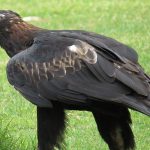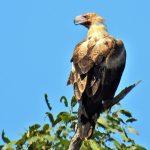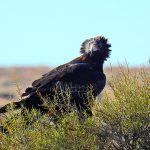WEDGE-TAILED EAGLE
The Wedge-tailed Eagle is Australia’s largest bird of prey and holds a significant place in the country’s ecosystem and culture. It is found throughout mainland Australia, as well as in southern Papua New Guinea and Indonesia. It inhabits a wide range of environments, from open woodlands and savannas to forests and mountain ranges.
This eagle is easily recognizable by its large size and distinctive wedge-shaped tail. Adults have dark brown plumage, a prominent hooked beak, and powerful talons. They can have a wingspan of up to 2.7 meters, which allows them to soar high in the sky.
Wedge-tailed Eagles are opportunistic predators. Their diet consists of a variety of prey, including small to medium-sized mammals (such as rabbits and wallabies), birds, and carrion (dead animals). They are known for their impressive hunting skills, which often involve soaring at high altitudes and using their keen eyesight to spot potential prey on the ground.
These eagles build large stick nests in trees or on cliff ledges. The nests are used for multiple breeding seasons and can become quite massive. They usually lay one to three eggs, and both parents take turns incubating the eggs and caring for the young.
The Wedge-tailed Eagle holds cultural significance for many Indigenous Australian communities. It is often regarded as a spiritual and totemic symbol, representing power and freedom. Its image has been used in traditional art and stories for generations.
The Wedge-tailed Eagle is not currently considered globally threatened. However the Tasmanian Wedge-tailed eagle (Aquila audax fleayi) is an endemic subspecies and is listed as endangered under the Tasmanian Threatened Species Protection Act 1995. It is included in the Federal list as an endangered subspecies.
Like many large birds of prey, it can face threats such as habitat loss, persecution, and collisions with vehicles. Conservation efforts are aimed at protecting their habitats and raising awareness about the importance of these majestic birds in maintaining healthy ecosystems.
While Wedge-tailed Eagles are not typically aggressive toward humans, they may become protective of their nests and young, which can lead to defensive behavior if approached too closely. In some cases, they may scavenge roadkill along highways, making them a familiar sight to travelers in rural areas.
Eagles are carrion feeders and are drawn to road-kills. If you see an eagle feeding on the side of the road, slow down! The eagle is a heavy bird and it is surprising how slow they are to take flight. Often they fly across the traffic and into the path of a car.














